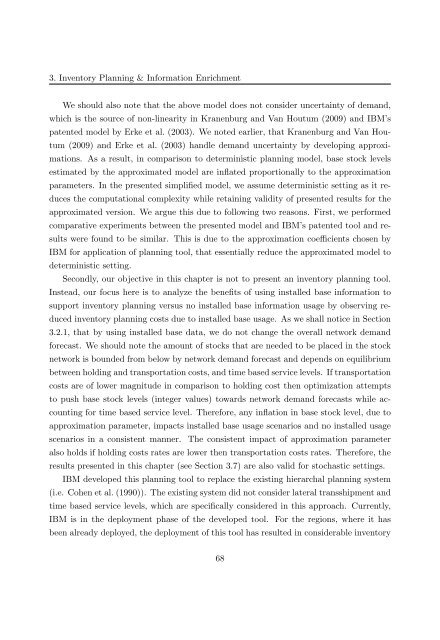Customer Information Driven After Sales Service ... - RePub
Customer Information Driven After Sales Service ... - RePub
Customer Information Driven After Sales Service ... - RePub
You also want an ePaper? Increase the reach of your titles
YUMPU automatically turns print PDFs into web optimized ePapers that Google loves.
3. Inventory Planning & <strong>Information</strong> Enrichment<br />
We should also note that the above model does not consider uncertainty of demand,<br />
which is the source of non-linearity in Kranenburg and Van Houtum (2009) and IBM’s<br />
patented model by Erke et al. (2003). We noted earlier, that Kranenburg and Van Houtum<br />
(2009) and Erke et al. (2003) handle demand uncertainty by developing approximations.<br />
As a result, in comparison to deterministic planning model, base stock levels<br />
estimated by the approximated model are inflated proportionally to the approximation<br />
parameters. In the presented simplified model, we assume deterministic setting as it reduces<br />
the computational complexity while retaining validity of presented results for the<br />
approximated version. We argue this due to following two reasons. First, we performed<br />
comparative experiments between the presented model and IBM’s patented tool and results<br />
were found to be similar. This is due to the approximation coefficients chosen by<br />
IBM for application of planning tool, that essentially reduce the approximated model to<br />
deterministic setting.<br />
Secondly, our objective in this chapter is not to present an inventory planning tool.<br />
Instead, our focus here is to analyze the benefits of using installed base information to<br />
support inventory planning versus no installed base information usage by observing reduced<br />
inventory planning costs due to installed base usage. As we shall notice in Section<br />
3.2.1, that by using installed base data, we do not change the overall network demand<br />
forecast. We should note the amount of stocks that are needed to be placed in the stock<br />
network is bounded from below by network demand forecast and depends on equilibrium<br />
between holding and transportation costs, and time based service levels. If transportation<br />
costs are of lower magnitude in comparison to holding cost then optimization attempts<br />
to push base stock levels (integer values) towards network demand forecasts while accounting<br />
for time based service level. Therefore, any inflation in base stock level, due to<br />
approximation parameter, impacts installed base usage scenarios and no installed usage<br />
scenarios in a consistent manner. The consistent impact of approximation parameter<br />
also holds if holding costs rates are lower then transportation costs rates. Therefore, the<br />
results presented in this chapter (see Section 3.7) are also valid for stochastic settings.<br />
IBM developed this planning tool to replace the existing hierarchal planning system<br />
(i.e. Cohen et al. (1990)). The existing system did not consider lateral transshipment and<br />
time based service levels, which are specifically considered in this approach. Currently,<br />
IBM is in the deployment phase of the developed tool. For the regions, where it has<br />
been already deployed, the deployment of this tool has resulted in considerable inventory<br />
68

















